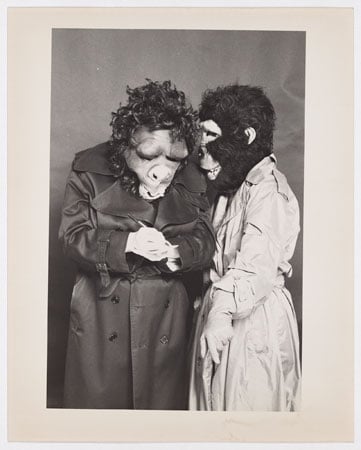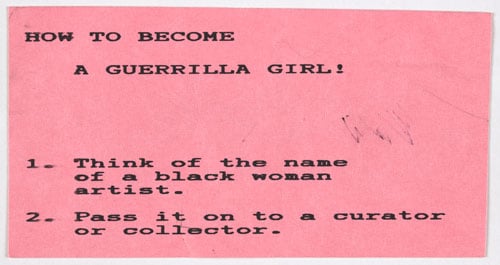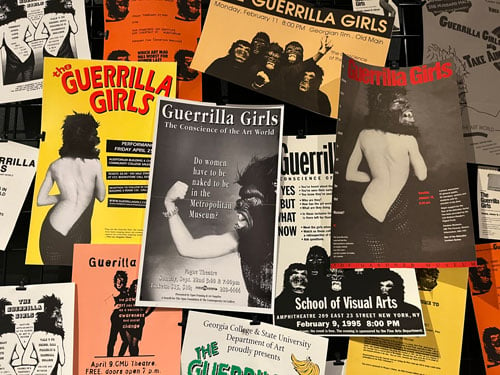BEHIND THE MASK

Guerrilla Girls, Do women have to be naked to get into the Met. Museum?, draft, ca. 1989. (Guerrilla Girls)
In 1984, the Museum of Modern Art in New York debuted a sprawling survey of contemporary art titled An International Survey of Recent Painting and Sculpture that featured work by two generations of artists from 17 countries. A press release touted the “extraordinary vitality of recent artistic production.” But the statement should have concluded with the phrase, “mainly by men” — because only 13 of the 165 artists in the show were women.
The lack of female representation drew a street protest by several women’s cultural organizations, but the picket got little attention. The failure, however, was not for naught — for out of that event emerged one of art’s most enduring activist collectives: the Guerrilla Girls, a group of anonymous women artists who for four decades have found pointed, theatrical ways to highlight the art world’s inequities. The group took noms de guerilla inspired by dead female artists. They staged actions decked out in gorilla masks — a move born out of a mistake, after one of the members misspelled “guerrilla” as “gorilla.” And they turned raw data about representation into wry graphics they put up on blank walls, in buses, and on billboards.
Among their most famous pieces is a 1989 poster that revealed that only 5% of the artists in the modern wing at the Metropolitan Museum of Art were women, while 85% of the museum’s nudes are female. The graphic featured a collage of Jean-Auguste-Dominique Ingres’s alluring Grande Odalisque (1814) wearing a gorilla mask, under a bold headline that asked, “Do women have to be naked to get into the Met. Museum?” (The answer all these years later is still: yes, yes they do.)

Guerrilla Girls Dressed as Detectives, 1987. (J. Paul Getty Trust / Guerrilla Girls)
Now, a small but very timely exhibition at the Getty Research Institute (GRI) — which acquired the group’s archive in 2008 — examines their legacy. Organized by Zanna Gilbert, Kristin Juarez, Thisbe Gensler, Alex Jones, Daniela Ruano Orantes, and Megan Sallabedra, How to Be a Guerrilla Girl gathers ephemera from the group’s first two decades of activity, including rare posters, mockups, brainstorming notes, as well as video and photos of their actions and talks.
The show also features a new commission: greeting visitors to the GRI is an analysis of the ways in which women are depicted in some of the works in the Getty’s own collection, and how these embody art history’s double standards. A wall vinyl of Diana and her Nymphs Bathing (1722-24), by French Rococo painter Jean-François de Troy, for example, shows the naked Roman goddess being tended to by a troupe of nymphs as a river god tries to ogle them from a distance. A thought bubble emerging from the image reads: “The guy who painted us was a member of the Royal Academy in Paris, where men could draw heaps of naked females but the women members were forbidden to draw even one naked male.”

How To Become a Guerrilla Girl, 1985-1987. (J. Paul Getty Trust / Guerrilla Girls)
From there, the exhibition recounts the rise of the group, presenting material related to some of their most important projects. This includes the now iconic poster The Advantage of Being a Woman Artist (1988), which lists among said advantages: “Having an escape from the art world in your 4 free-lance jobs.” It also includes their satirical gallery “report cards,” which tracked female representation at New York art spaces. Laid out to resemble a grade school report card, these featured the number of women in each gallery’s roster, along with hand-written remarks like “Boy crazy.” The artists then pasted them around the very Manhattan galleries they critiqued.
As the Guerrilla Girl known as Käthe Kollwitz once told Art21, these actions were liberating: “Those of us who were unfairly left out of the system, it was like a breath of fresh air. It seemed daring. It seemed exciting. And the people on the posters were really pissed off.”
Archival exhibitions can be a bit of a drudge, full of vitrines stuffed with odds and ends. But the installation design for this show is engaging and dynamic — featuring a wall of TV monitors that play historical videos, as well as oversized wall graphics that borrow from the language of advertising, a form the Guerrilla Girls have used to brilliant effect.

The exhibition design pays homage to the Guerrilla Girls' dynamic, graphic style. (Carolina A. Miranda)
Most significantly, the show provides an important window into the ways artists have engaged the issues that plague the art world — through direct activism, but also through art. Like many other artists who have worked in this vein — Hans Haacke, Fred Wilson, William Powhida, Andrea Fraser, Lorraine O’Grady — the Guerrilla Girls don't just track numbers. They highlight the systemic issues that consistently elevate some voices over others. As Guerrilla Girl Frida Kahlo told The Late Show’s Stephen Colbert in 2016. “Art should look like the rest of our culture,” she said. Otherwise, “it’s not really history of art, it’s a history of power.”
And at a moment in which some seek to hoard power, the Guerrilla Girls’ techniques — which marry humor with hard fact and mediagenic spectacle — are absolutely worth studying.
🍌🍌🍌
How to Be a Guerrilla Girl is on view at the Getty Research Institute through April 12th; getty.edu. Plus, on Jan. 17th, the Guerrilla Girls will be in conversation with author Roxane Gay.
.png?upscale=true&width=1200&upscale=true&name=email(600x74).png)